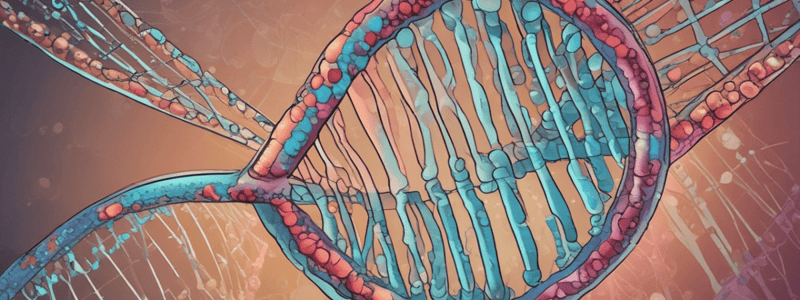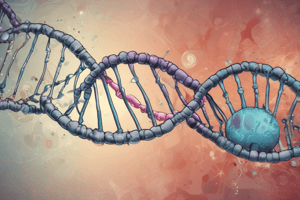Podcast
Questions and Answers
What is the primary consequence of inadequate DNA repair?
What is the primary consequence of inadequate DNA repair?
- Cancer (correct)
- Genetic mutation
- Genomic instability
- Aging
What is the primary function of DNA N-glycosylase in DNA Base excision repair?
What is the primary function of DNA N-glycosylase in DNA Base excision repair?
- To generate a 5'-phosphate terminus
- To nick on the 3' side of the AP site
- To extend the 3'-OH terminus
- To detect and remove incorrect bases (correct)
What is the relationship between DNA Base excision repair and human disease?
What is the relationship between DNA Base excision repair and human disease?
- BER is only required for DNA methylation
- Many cancers have mutations in BER genes (correct)
- Mutations in BER genes lead to genetic disorders
- BER is only involved in demethylation
What is the primary difference between DNA Base excision repair and nucleotide excision repair?
What is the primary difference between DNA Base excision repair and nucleotide excision repair?
What is the primary function of AP endonuclease in DNA Base excision repair?
What is the primary function of AP endonuclease in DNA Base excision repair?
What is the primary importance of DNA repair?
What is the primary importance of DNA repair?
What is the primary function of DNA polymerase in DNA Base excision repair?
What is the primary function of DNA polymerase in DNA Base excision repair?
What is the primary type of DNA repair that corrects mismatched bases?
What is the primary type of DNA repair that corrects mismatched bases?
What is the primary function of Ku70/Ku80 proteins in NHEJ?
What is the primary function of Ku70/Ku80 proteins in NHEJ?
What is the result of ligation in NHEJ?
What is the result of ligation in NHEJ?
What is the primary requirement for cancer to propagate?
What is the primary requirement for cancer to propagate?
What is the advantage of NHEJ over other DNA repair mechanisms?
What is the advantage of NHEJ over other DNA repair mechanisms?
What is the primary function of Homologous Recombination in DNA repair?
What is the primary function of Homologous Recombination in DNA repair?
What is a potential disadvantage of NHEJ?
What is a potential disadvantage of NHEJ?
What is the primary characteristic of Bloom's Syndrome?
What is the primary characteristic of Bloom's Syndrome?
What is the purpose of End Processing in Non-homologous End Joining (NHEJ)?
What is the purpose of End Processing in Non-homologous End Joining (NHEJ)?
What is the final step of NHEJ?
What is the final step of NHEJ?
What is the primary difference between Homologous Recombination and Non-homologous End Joining (NHEJ)?
What is the primary difference between Homologous Recombination and Non-homologous End Joining (NHEJ)?
What is the result of the error-prone nature of NHEJ?
What is the result of the error-prone nature of NHEJ?
What is the relationship between two different strains of an organism that have homozygous recessive mutations that produce the same phenotype but do not reside on the same (homologous) gene?
What is the relationship between two different strains of an organism that have homozygous recessive mutations that produce the same phenotype but do not reside on the same (homologous) gene?
What is the primary purpose of Transcription Coupled Repair?
What is the primary purpose of Transcription Coupled Repair?
What is the consequence of Resumption of Transcription?
What is the consequence of Resumption of Transcription?
During the process of nucleotide excision repair, what occurs at the damaged site?
During the process of nucleotide excision repair, what occurs at the damaged site?
How many methods of Double-Strand Break Repair are mentioned?
How many methods of Double-Strand Break Repair are mentioned?
What is the result of the double incision step in nucleotide excision repair?
What is the result of the double incision step in nucleotide excision repair?
What is the purpose of DNA unwinding during Transcription Coupled Repair?
What is the purpose of DNA unwinding during Transcription Coupled Repair?
What is the difference between Transcription Coupled Repair and Global Genomic Repair?
What is the difference between Transcription Coupled Repair and Global Genomic Repair?
What is the role of RNA polymerase during Transcription Coupled Repair?
What is the role of RNA polymerase during Transcription Coupled Repair?
What is the final step of the nucleotide excision repair process?
What is the final step of the nucleotide excision repair process?
What is the result of the removal of the damage-containing oligonucleotide during nucleotide excision repair?
What is the result of the removal of the damage-containing oligonucleotide during nucleotide excision repair?
Flashcards are hidden until you start studying
Study Notes
DNA Repair and Cancer
- DNA is the only biological macromolecule that is repaired, while others are replaced.
- Cancer is a consequence of inadequate DNA repair.
Types of Excision Repair
- Mismatch repair
- Base excision repair
- Nucleotide excision repair
DNA Base Excision Repair
- Main enzyme used: DNA Glycolysaes
- Process:
- Removal of incorrect base by DNA N-glycosylase to create an AP site
- An AP endonuclease nicks on the 5' side of the AP site to generate a 3'-OH terminus
- Extension of the 3'-OH terminus by a DNA polymerase to repair the strand
Relationship between Base Excision Repair and Human Disease
- Many cancers have mutations in BER genes
- Links to cognition: DNA methylation and demethylation required for memory formation and maintenance
- Demethylation of specific genes dependent on BER
Nucleotide Excision Repair
- General process:
- Damage recognition causes binding of a multi-protein complex at the damaged site
- Double incision of the damaged strand several nucleotides away from the damaged site
- Removal of the damage-containing oligonucleotide
- Filling in of the resulting gap by a DNA polymerase and ligation
Types of Nucleotide Excision Repair
- Transcription Coupled Repair (transcription only)
- Global Genomic Repair (happens to DNA at any time)
Transcription Coupled Repair
- Specific mechanism of NER that targets and repairs DNA damage that obstructs transcription
- Process:
- Detection of DNA damage by RNA polymerase
- Recruitment of repair factors to the site of damage
- DNA unwinding to allow access to the damaged DNA
- Excision and repair of the damaged DNA strand
- Resumption of transcription
Complementation
- Ability of two mutants in combination to restore a normal phenotype
- Also refers to a relationship between two different strains of an organism with homozygous recessive mutations
Cancer Propagation
- Requires accumulation of mutations in cells capable of propagating
Bloom's Syndrome
- Helicase deficiency
- Autosomal recessive
- Characteristics:
- Short stature
- Sun-sensitive, red rash on the nose and cheeks
- Mild immune deficiency
Double-Strand Break Repair
- 2 methods:
- Homologous recombination
- Non-homologous end joining (NHEJ)
Homologous Recombination
- Based on the ability of single DNA strands to find regions of near-perfect homology (genes) elsewhere in the genome
Non-Homologous End Joining (NHEJ)
- Process:
- Detection of DNA damage
- End processing to trim/modifying broken ends
- Binding of NHEJ proteins to the ends of the broken DNA
- Ligation to join the processed ends
- Completion of repair to make the DNA molecule continuous again
Advantages and Disadvantages of NHEJ
- Advantage: relatively quick and efficient DNA repair mechanism
- Disadvantage: may introduce mutations due to its error-prone nature
Studying That Suits You
Use AI to generate personalized quizzes and flashcards to suit your learning preferences.




